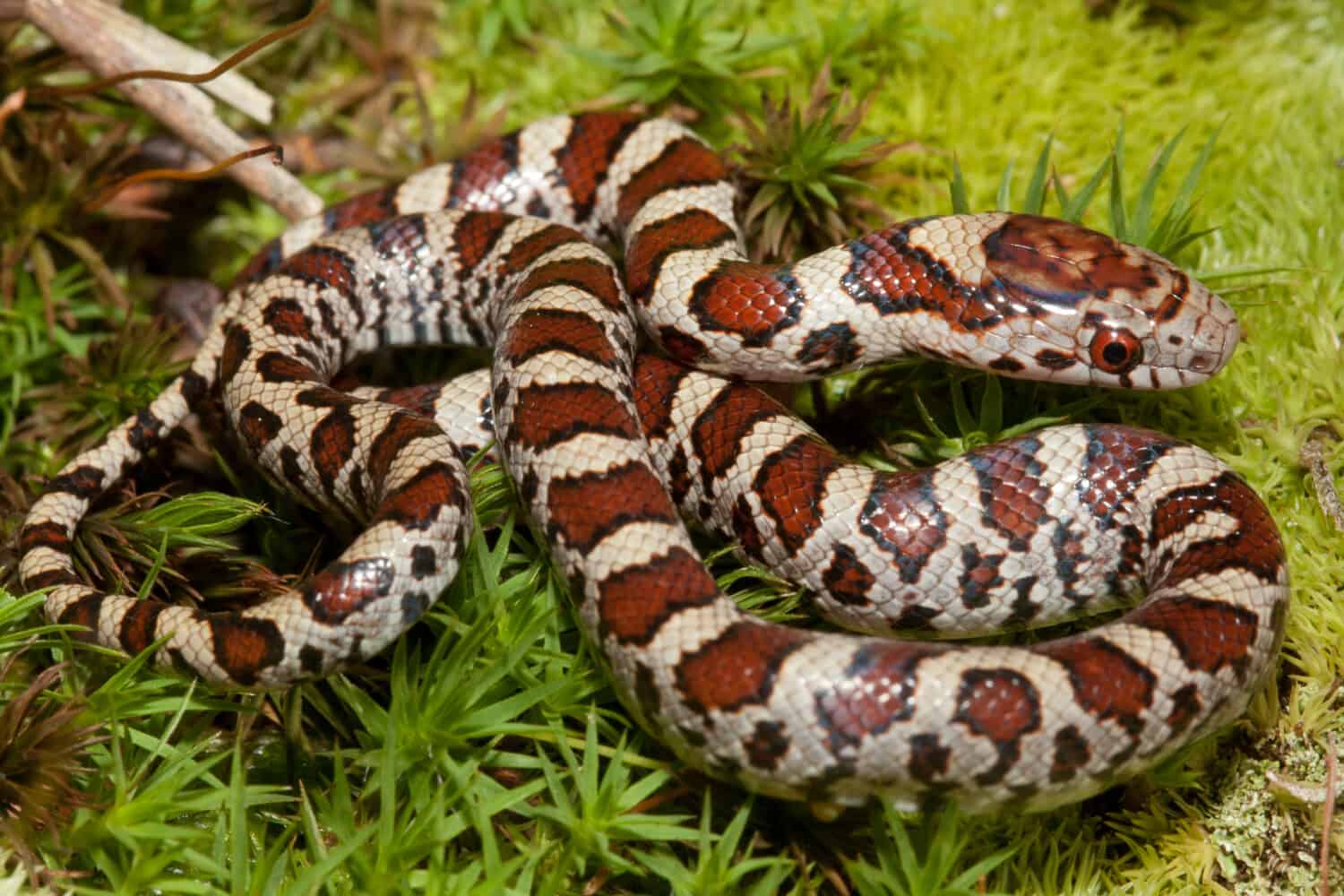Milk snakes are a relatively common sight across an incredibly wide range. They inhabit every U.S. state along the east coast, from Maine to Florida, as well as many in the Midwest, from Minnesota to the Dakotas. Their range even spans southward into Mexico, through the entirety of Central America, and into northern South America. These are some pretty adaptable snakes!
Though their appearances are usually pretty similar, these snakes can exhibit quite a range of coloration, patterns, and sizes. In this article, we’ll have a look at how milk snakes stack up in terms of size and find out which one is the biggest. We’ll also learn about why milk snakes are so colorful and find out what sets them apart from each other taxonomically.
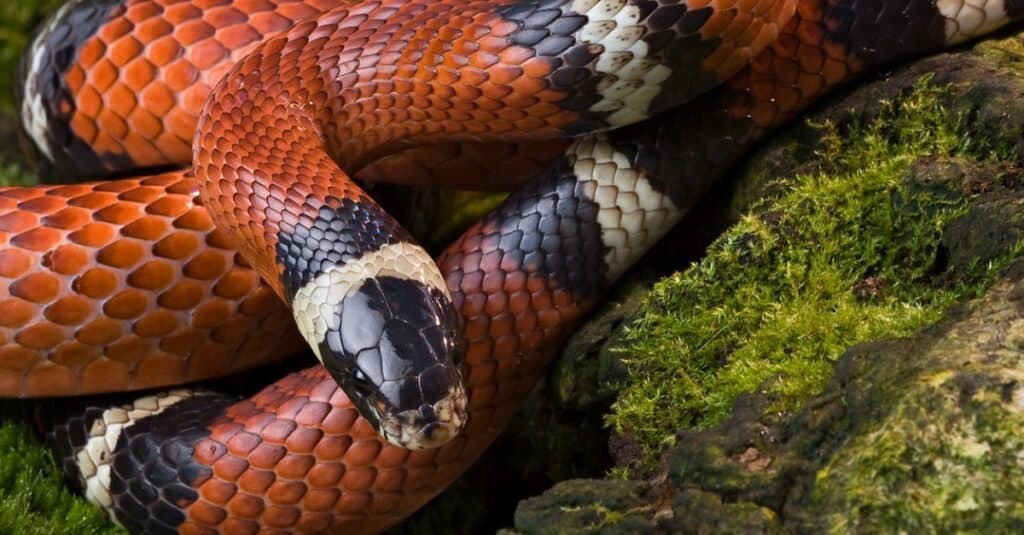
Milk snakes are incredibly diverse! Their range stretches from the far south of
Canada
, throughout the east coast and midwest of the United States, all the way down into Central and South America!
©iStock.com/wScottLoy
How Are Milk Snakes Classified?
Historically, all milk snakes belonged to the same species, Lampropeltis triangulum. From there, they received their subspecies based on their unique traits. At one time there were 24 subspecies! Today, herpetologists have narrowed them down into seven distinct species. This reclassification is in its early stages and, like most developments in taxonomy, is subject to change. The researchers who conducted the study note that breaking down the multitude of subspecies into seven distinct species better accounts for the genetic diversity of milksnakes worldwide.
Before this particular genetic study, herpetologists defined the many subspecies of milk snakes by their color, pattern, and habitat range. However, this turns out to be an unreliable method of determining these animals’ lineage. Because these snakes rely so heavily on mimicry, evolutionary pressure can cause different coloration and patterns, even within a single species. The same pressure can also cause two genetically distinct species to appear strikingly similar. This makes it extremely difficult to separate species and determine ancestry based on visual cues. Rather than define them by their physical traits, the researchers performed extensive genetic analysis on nearly 300 different snakes which led to these new classifications.
How Big Do Milk Snakes Get?
With new taxonomy to sort the many species of milk snakes, we can now talk more confidently about how these snakes rank in terms of size. Below, we’ll talk about which milk snakes are the biggest and the smallest and learn a little bit more about each one.
The Largest Milk Snake on Record
Out of all the species of milk snakes, the largest by far is the black milk snake (Lampropeltis micropholis). These snakes previously held the subspecies name Lampropeltis triangulum gaigeae. They are strong, muscular snakes and are popular snakes among reptile keepers. By adulthood, they usually weigh around 3 pounds. Black milk snakes in the wild will often grow to between 3 and 6 feet long, but some can get much longer. The longest black milk snake on record was over 7 feet long! That’s over a foot longer than the height average adult human.
Black milk snakes usually reside in the wet, high-altitude forests of Central and South America, usually between 5,000 and 7,400 feet in elevation. Sometimes, however, they appear at elevations as low as 4,300 feet. Because they live at higher elevations, they have adapted to thrive at lower temperatures than many snakes. The daytime high temperatures in their native habitats often do not exceed 85 degrees Fahrenheit.
In the wild, these snakes feed primarily on rodents like mice, rats, and voles. They will also eat lizards, frogs, birds, and many types of eggs. While most milk snakes share distinct combinations of red, white, yellow, and black banding to mimic various coral snakes, the black milk snake is quite different. Though young snakes may exhibit obvious banding, many adults tend to show muted patterning or none at all. Instead, they are completely or almost completely black. When red or white scales do appear, they are usually dominated by black ticking. Compare the two snakes in the photos below:
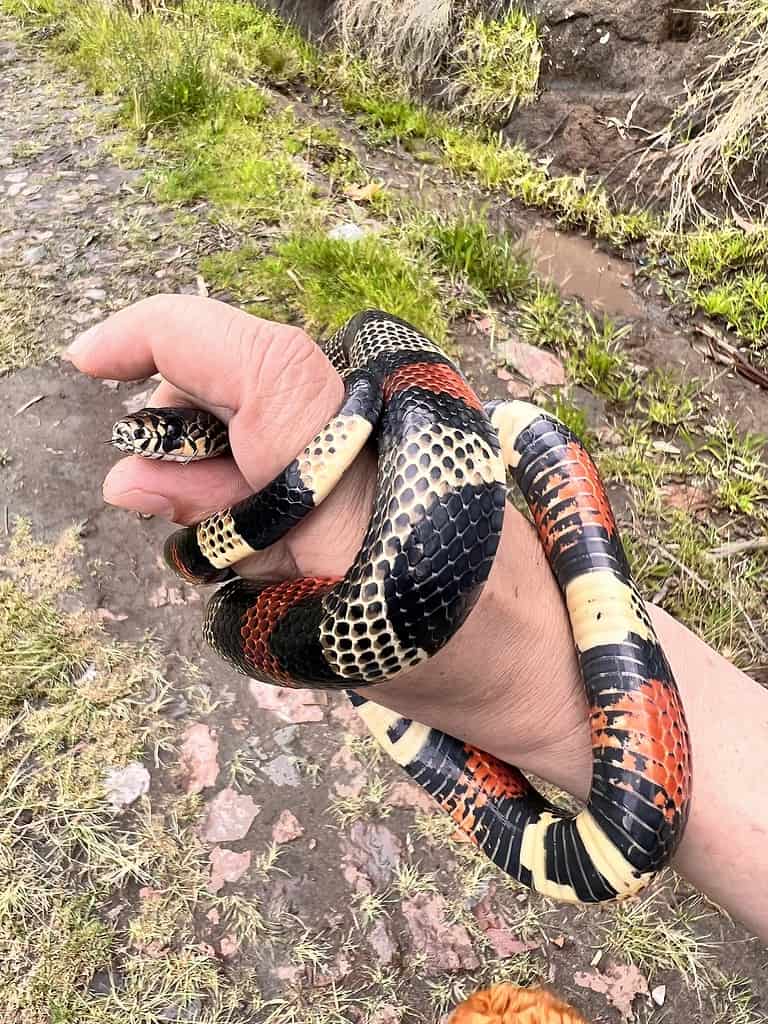
A black milk snake,
Lampropeltis micropholis, in Ecuador. Note the dominant black markings on the cream- and red-colored scales. The banding is obvious on this one. However, banding can be very difficult to detect in many adults of this species.

Another black milk snake, still
Lampropeltis micropholis, this time in Colombia. While the banding is still visible here, it is almost entirely obscured.
The Smallest Milk Snake on Record
While the black milk snake can get impressively large for a colubrid, the New Mexico milk snake (Lampropeltis gentilis) is the smallest species on record. Previously, this snake held the subspecies name Lampropeltis triangulum celaenops. These small, colorful snakes rarely grow longer than 2 feet at maturity. Oftentimes, they will only reach between 14 and 18 inches in length. That’s only about as long as the average adult forearm and hand, from the tip of the middle finger to the elbow. They tend to be very tiny as hatchlings as well, averaging only 6 inches long.
Snakes of this species tend to be particularly shy. While some people consider them to be uncommon, others believe that their rarity is more likely due to their subterranean nature. They spend most of their lives underground, emerging from their burrows most frequently in the spring or during summer nights. When these milk snakes do emerge from their burrows, they spend a lot of time hunting for small prey. New Mexico milk snakes feed on a diet similar to that of their much larger relatives, just smaller in size. They seek out small rodents, lizards, various eggs, and even smaller snakes!
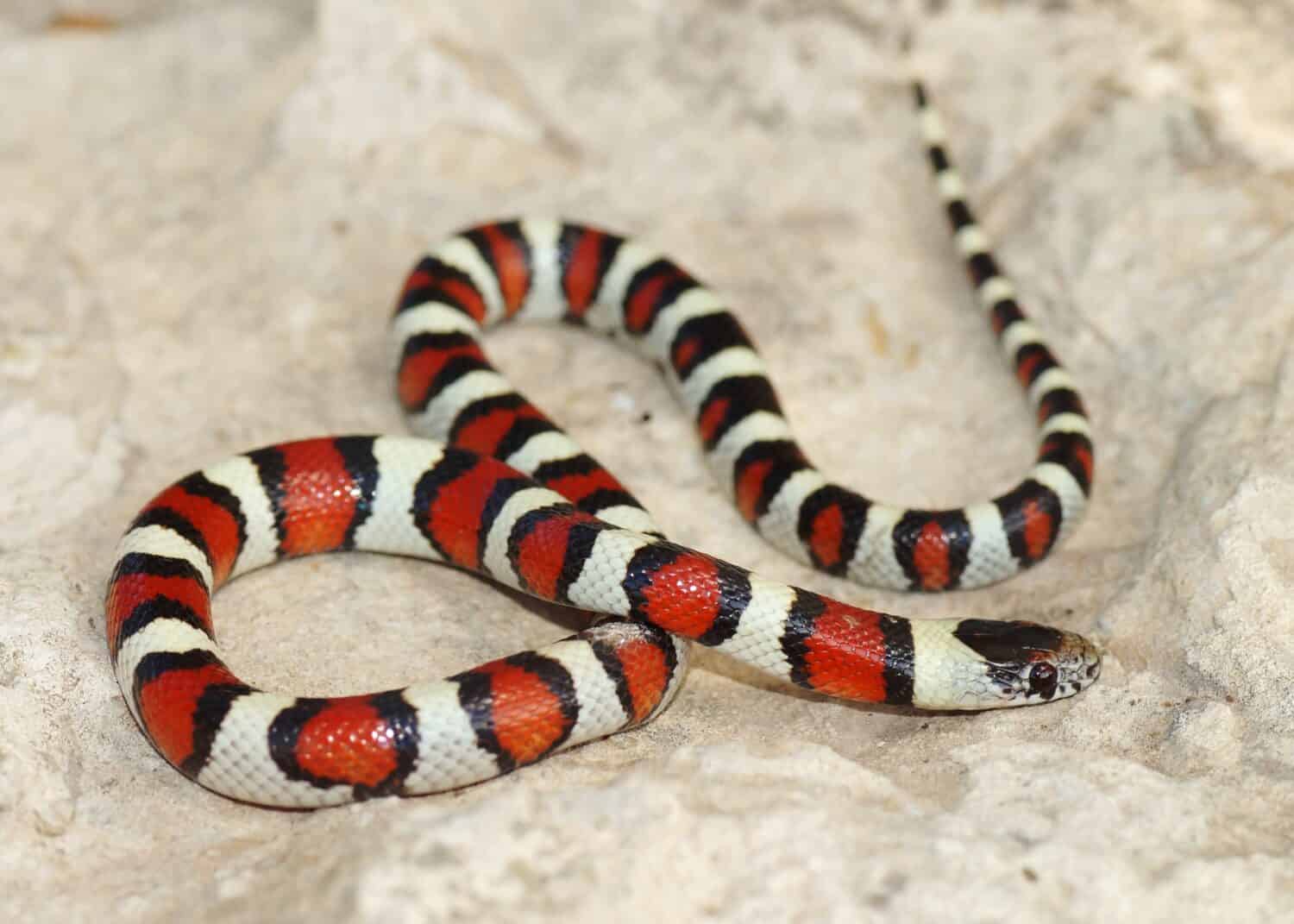
The New Mexico milk snake, once its subspecies, is now recognized as
Lampropeltis gentilis. This diminutive milk snake only averages 18 inches in length!
©Matt Jeppson/Shutterstock.com
Why Are Milk Snakes So Colorful?
People frequently mistake milk snakes for venomous copperheads, coral snakes, or pygmy rattlesnakes, and often steer clear of them. This is all according to the snake’s plan. Milk snakes are nonvenomous and make use of a survival strategy called Batesian mimicry to ensure their safety. This means that their colors, shapes, and patterns make them difficult to distinguish from different, more dangerous animals. Because they so closely resemble venomous snakes, predators don’t often take the risk of interacting with them and instead leave them alone.
Batesian mimicry isn’t the only type of mimicry in the natural world, though. Mimicry in general is a very successful evolutionary strategy, and many other animals make use of it as well! Insects like katydids and stick insects have adapted special shapes that help them blend in flawlessly with the plants around them. Some robber flies imitate bumblebees to give them the jump on unsuspecting prey. Even plants make use of mimicry! Some succulents appear similar to rocks and pebbles or even the soil they live in to prevent being eaten. Many orchids even masquerade as other plants to trick insects into pollinating them.
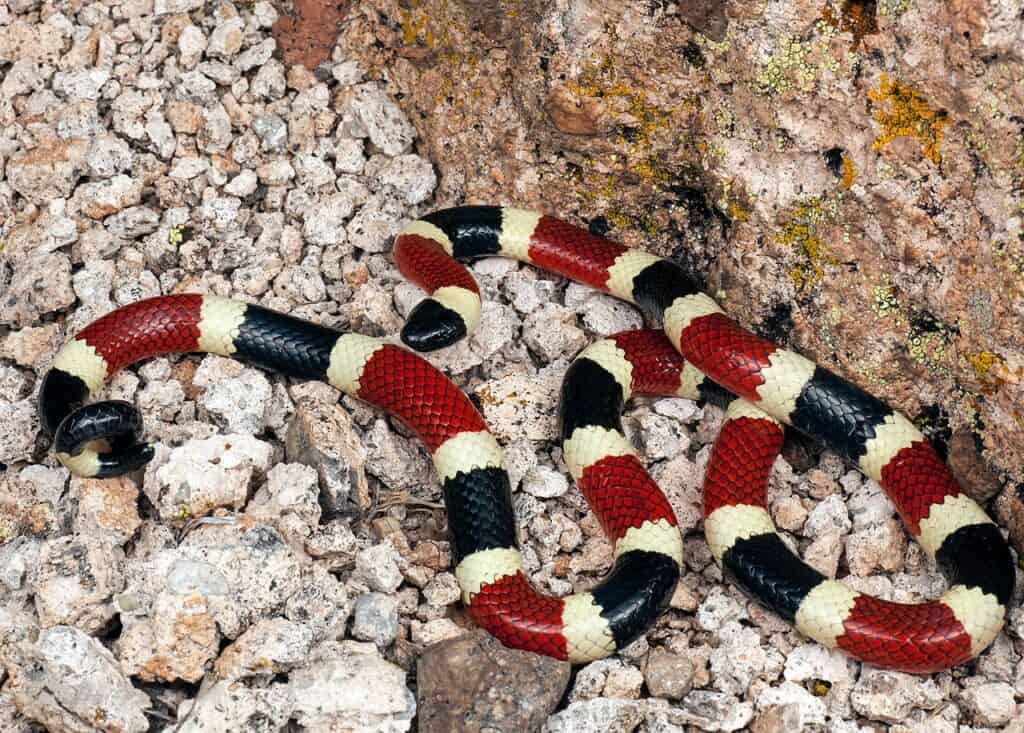
A photo of the Arizona coral snake (
Micruoides euryxanthus). Many people (and other animals) mistake harmless milk snakes for venomous coral snakes, like the one above. Because of a type of mimicry, their colors and patterns appear very similar and most predators steer clear.
©CC BY-SA 2.0
Where You’re Likely to Encounter a Milk Snake
Because of the vast range these snakes occupy, the places they might show up can vary from location to location. Take the two snake species above for example. The black milk snake lives only in high-altitude cloud forests, while the New Mexico milk snake is perfectly happy hiding among dry, rocky hillsides or scrubby grassland.
These snakes are largely nocturnal hunters, so it’s not very likely that you’ll encounter one during the daytime. If you do, however, you’ll likely find it in or near a barn, brush pile, or wood stack. They also hide under logs, rocks, and low vegetation during the day, but almost any object lying around can provide them with an attractive cover. Lucky homeowners may occasionally find them in crawlspaces or basements as well. While some might cringe at the thought, it’s good to remember that these snakes aren’t there to hurt you. They’re just looking to get by, and kindly providing extermination services by doing so!
Discover the "Monster" Snake 5X Bigger than an Anaconda
Every day A-Z Animals sends out some of the most incredible facts in the world from our free newsletter. Want to discover the 10 most beautiful snakes in the world, a "snake island" where you're never more than 3 feet from danger, or a "monster" snake 5X larger than an anaconda? Then sign up right now and you'll start receiving our daily newsletter absolutely free.
Thank you for reading! Have some feedback for us? Contact the AZ Animals editorial team.

